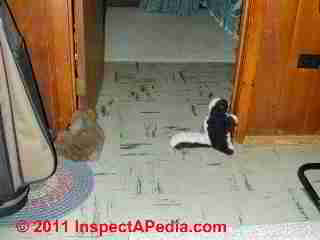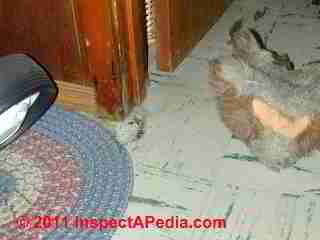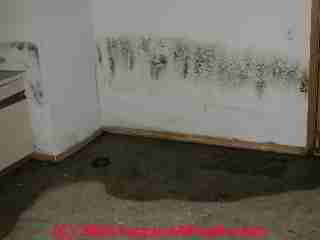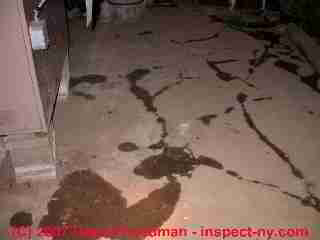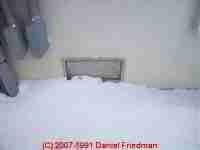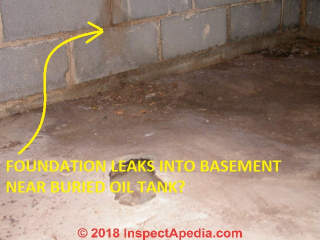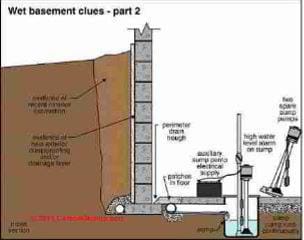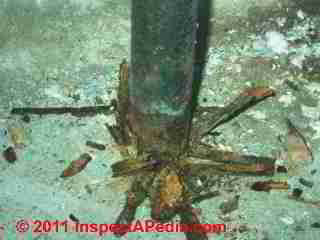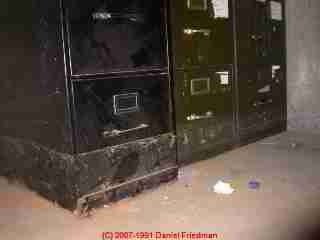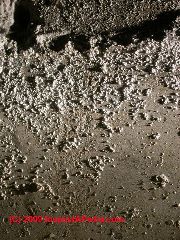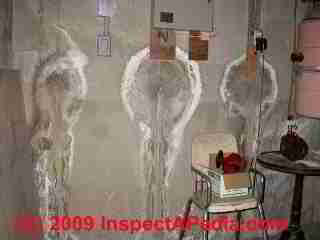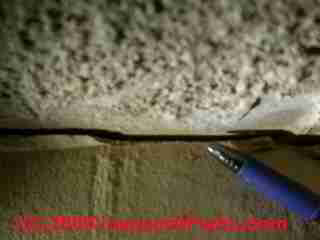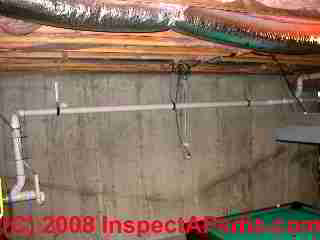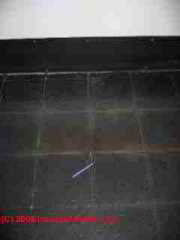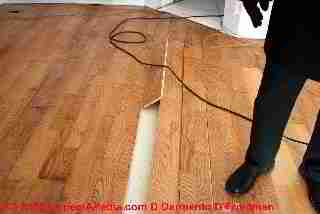 Wet Basement Diagnosis & Cure
Wet Basement Diagnosis & Cure
How to Inspect for Basement Leaks or Moisture
- POST a QUESTION or COMMENT about how to determine the extent and history of basement water leakage at a building
Wet or damp basement cause, diagnosis, cure & prevention:
This article describes visual inspection methods and clues to detect basement leaks, water entry, flooding, or just high moisture problems.
Finding where basement or crawl space water is coming from is the first step in fixing foundation leaks and wet basements. Here we illustrate common basement water entry leak points and signs that can be seen from inside the building.
InspectAPedia tolerates no conflicts of interest. We have no relationship with advertisers, products, or services discussed at this website.
Wet Basement Diagnosis: a Guide to Inspecting for Basement Moisture, Leaks, Flood History, or Chronic Water Entry
 Wet basement diagnosis & cure: how to Inspect inside for basement or foundation leaks, basement or crawlspace moisture, a first step in fixing wet basements and indoor moisture or mold contamination.
Wet basement diagnosis & cure: how to Inspect inside for basement or foundation leaks, basement or crawlspace moisture, a first step in fixing wet basements and indoor moisture or mold contamination.
Here we include a checklist and photographs of clues indicating sources of foundation leaks, basement leaks, water entry, high moisture
[Click to enlarge any image]
Image provided courtesy of Carson Dunlop Associates, a Toronto home inspection, education & report writing tool company [ carsondunlop.com ].
Article Contents
- RISING DAMP vs WATER ENTRY
- WET BASEMENT INSPECTION POINTS
- 3 LEVELS of BASEMENT WETNESS - how wet is it?
- BUCKLING LAMINATE or WOOD FLOORING
- CONCRETE FOUNDATION WALL LEAKS AT COLD POUR JOINTS
- CONCRETE FOUNDATION WALL LEAKS at FORM TIES
- CONCRETE FOUNDATION WALL LEAKS at WALL CRACKS
- CONCRETE BLOCK FOUNDATION LEAKS at FOOTING DRAINS
- EIFS SYNTHETIC STUCCO WALL or WINDOW SILL LEAKS INTO BASEMENT / GARAGE
- FLOOD LINES on BASEMENT CONTENTS or FLOOD VENTS INDICATE FLOODING
- FLOOR TILES SHOW BUILDING LEAK HISTORY
- FLOOR-WALL JOINT LEAKS
- HIDING WATER STAINS on BASEMENT FLOOR & DOOR TRIM
- RISING DAMP DEFINED, CAUSES
- RUSTED METAL BEAMS, POSTS, LALLY COLUMNS = WET BASEMENT
- SUMP PUMPS as BASEMENT WATER ENTRY INDICATORS
- SIGNS of BASEMENT LEAKS: ROT, STAINS, WATER MARKS
A clear answer to where basement leaks originate avoids falling prey to the rising ground-water or there's a stream under the house fib that sometimes leads homeowners to installing an expensive fix for the wrong problem.
Where to Start Diagnosing Building Water Entry & Wet Basements - Outdoors
In this article we begin with a catalog of basement or crawl space water entry signs seen from inside the structure.
Our opinion is that an expert inspection for a building basement or crawl spacewater entry problem begins outdoors with an inspection of the site, roof drainage, and similar features.
See EXTERIOR WATER SOURCE ELIMINATION
But there are plenty of indoor clues of water leakage problems in buildings, and they can be found on every level of the structure.
Is Your Indoor Moisture or Water Problem Rising Damp, or do you have Basement or Crawl Space Water Entry Leaks?
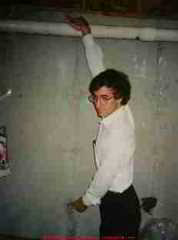
This article explains procedures for inspecting in the building basement for signs of leaks and for sources of building moisture that could even be appearing as attic condensation or building mold.
The photo above illustrates the author, DJF, pointing to a difference between the point of water entry and the top of the foundation wall - this picture is very old, almost half a century. So am I, fatter and with much less hair now.
But building water entry troubles are a lot older.
Rising damp,
according to the Building Doctor Joseph Knight, a Chartered Surveyor in the U.K. (a place where they know about dampness), describes rising damp as
... upward movement of moisture through the pores in masonry, caused by ... capillary action which relies on the surface tension of moisture to draw moisture vertically [upwards into the building foundation and masonry walls] from the ground.[4]
Think water molecules moving upwards through building materials, not puddles on the floor.
Building water leakage,
in our view [DF] refers leakage of liquid water into a structure from any source: roof leaks, roof spillage on the ground that passes through the foundation wall (our photo at left), surface runoff or groundwater that leaks into a building through its lowest level floor or lower foundation walls.
The distinction between rising damp and water leaks is is important because a proper diagnosis of the cause of high moisture or actual wet conditions assures that we fix the right problem.
If water is leaking into the basement from roof spillage on the ground outside, the best fix starts with the roof gutter and downspout system, not with installing an interior perimeter drain or foundation waterproofing to "fix rising damp" as may be sold by some contractors who are more in a rush to do the job than to diagnose the problem.
The photograph at page top shows a very wet basement with water stains high on the foundation walls - telling us that the cause of this water entry is obviously not "rising damp" nor "construction over an underground stream".
The photo at left shows the author (DF) as a much younger and better dressed building inspector than today, pointing out that water stains on the foundation wall were originating at the very top of the foundation . Pointing out the location and height of water stains and wet marks on a foundation wall is a useful diagnostic step in figuring out where basement water is coming from.
While rising damp can indeed produce moisture and efflorescence on building walls and floors in most cases in most parts of the world, building water entry in a crawl space or basement is due to actual water leaks, not rising damp.
See EFFLORESCENCE SALTS & WHITE DEPOSITS for details.
Preventing rising damp
builders constructing masonry foundations and perhaps aboveground masonry walls in an area where rising damp is also a concern usually address the problem by including a layer of moisture-resistant materials in the masonry wall just above ground level as the wall is being built.
Preventing building water leaks & wet basements
we describe common water entry or leak points in basements and crawl spaces as part of our discussion of
both
ATTIC LEAKS MOISTURE or MOLD (where did that moisture originate?)
and
also WATER ENTRY in BUILDINGS (how to keep a building dry and at proper moisture levels).
Wet basement Inspection Points

These basement water entry inspection recommendations are based on 35 years of building inspections, on the observation of the locations of moisture, mold, ice dams, condensation stains, efflorescence & white or brown deposits, water stains, and other clues in buildings, and on the correlation of these clues with the roof venting conditions at those properties as well as frequent literature review and discussion among professionals.
Carson Dunlop Associates' sketch (left) shows some clues that easily indicate a history of wet basement troubles.
Readers should see WATER ENTRY in BUILDINGS and
also see WET BASEMENT PREVENTION where we describe the basics of preventing basement or crawl space water entry, report a foundation collapse case study, and describe some simple steps that may cure a wet basement without major expense.
Cute Little Stuffed Animals Hiding Water Stains on Basement Floor and Door Trim
Basement trim water stains can be a good indicator of a history of wet basement floors.
In our photos we illustrate a cute attempt by someone to "hide" the water stains on basement door trim by placing little stuffed animals in the doorway.
First the skunk, then it's cousin, a little squirrel just happened to tip over, disclosing that the little rascals had been hiding water stains at floor level on the door trim.
A closer look [Click to enlarge any image] shows water stains along the wood baseboard trim too.
Moisture from a wet building basement or crawl space travels up through the building
where it can often condense in an attic, causing mold, frost, and even rot in a building if proper under-roof ventilation is missing.
In the case of the basement shown at page top, we also need to correct the cause of basement water entry - in this case almost certainly it's a roof spillage or gutter problem since we see water stains so high on the foundation walls.
In the basement shown at left there has been flooding, a mold problem, and perhaps other moisture damage in the building.
But further investigation, both outside and indoors, will be needed to fully explain why water is on the basement floor.
3 Levels of Basement "Wetness" - Inspecting in the Basement for Sources of Building Leaks or Moisture Appearing as Attic Condensation
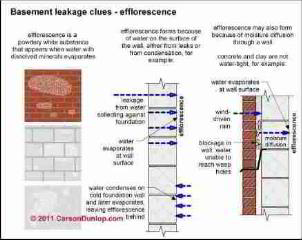
Because building leaks, water entry, and flooding and their related damage, ranging from structural damage to costly mold damage are such a large topic, we divide our building water problem inspection, discussion, and advice into these major categories:
Three Degrees of Building Wetness
We divide our wet building thinking into these degrees of severity: Damp, Wet, and Flooding. Here are our definitions of each of these levels of building water entry:
1. Damp or moist conditions in a building:
in most areas basements and crawl spaces are damp; certainly anywhere that we have masonry construction below ground level we can expect higher humidity and dampness; depending on the degree of moisture and other building conditions, damp or moist conditions can cause mold or other building problems.
Carson Dunlop Associates' sketch (above-left) illustrates how efflorescence is deposited on building interior walls.
Details about this moisture or leak clue are
at EFFLORESCENCE SALTS & WHITE DEPOSITS.
Watch out: as we demonstrate at MOISTURE METER STUDY, using infrared scanners will not reliably detect old or historic water entry leakage if the leak area happens to be dry at the time of the scan.
A similar limitation applies to use of moisture meters.
Evidence of moisture is a reliable indicator, but absence of moisture is not - moisture may be present but beyond the ability of the instrument to reach, such as a wet inner surface of exterior wall sheathing.
2. Wet conditions in a building:
some limited areas of a basement or crawl space floor have been or are regularly wet or showing puddles in some weather conditions, but water does not extend over the entire building floor.
As our photo shows, water seeps up through cracks in this Staatsburg NY basement floor. Staatsburg is built on a wet swampy flat area in Dutchess County. If your basement is dry, you probably don't live in Staatsburg.
3. Flood conditions in a building:
water extends over the entire building floor, extending from a fraction of an inch to virtually filling the building and even flooding upper floor levels if a building is located in a flood plain or flooded area.
At below left our client points out that basement flooding had reached at least this far up from the basement floor - leaving mud on the bottom of an expansion tank. In this neighborhood we also found flood-deposited mud atop sill plates at foundation wall tops.
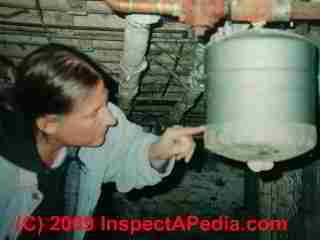
Our second photo, below, is really an outdoor clue, though you might see this from the inside: it's a foundation flood vent, indicating that the builder thinks the building is in a flood prone area.
Photographs of Signs of Basement Water Entry

Another important observation about the causes of and cures for attic moisture condensation is that buildings with an attic moisture condensation problem very often have wet basement or crawl space water entry problems.
In fact even before entering an attic to inspect for moisture, while still outside
I often look at excessively curled asphalt shingle roofs and suspect a basement water entry problem.
In the photograph shown here our client points to moisture stains originating high on a masonry block
basement wall.
The presence of moisture staining high on the wall confirm that the water source is either roof runoff spillage against the foundation or a surface water runoff problem. This is not a case of "rising groundwater" or "a buried stream" nor "rising damp" - two explanation she was given.
A careful study of the pattern and location of moisture stains gives important diagnostic information about the probable source of basement water entry and of leaks or building moisture problems in general.
If the water stains had originated on the foundation wall below ground level or near the wall bottom we might suspect another cause.
Because it's true that some buried objects near a foundation can contribute to water entry. In our photo below there were water stains at just one point along the foundation wall, and they occurred low on the wall.
That led us to look for a buried object, water line, sewer line, even a gopher or groundhog hole as a local condition directing roof spillage into the foundation wall.
See WATER ENTRY FROM BURIED TANKS for details.
Or if you see animal or other holes in the ground surface near the point of water entry
Sump Pumps As Basement Water Entry Indicators
Carson Dunlop Associates' sketches show some additional clues that easily indicate a history of wet basement troubles as well as how people may be dealing with recurrent basement flooding by an interior perimeter drain, exterior drainage, or sump pumps.
Watch out: basement leaks and high moisture travel throughout the building
Actual basement flooding or simply high basement moisture forms a moisture source in a building that affects the entire structure.
An attic inspection that discovers attic condensation should direct you to go back to inspect the basement for leaks.
See ATTIC CONDENSATION CAUSE & CURE
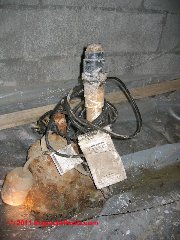
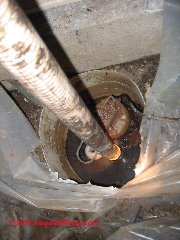
Our photos show part of a collection of basement sump pumps found in a single location - a strong indicator of a history of basement water entry trouble.
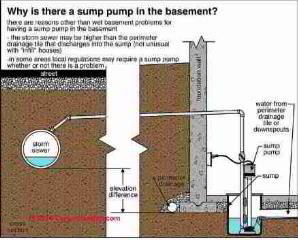
Moist air rises through the building by natural convection, eventually
finding its way into the attic or roof cavity. If the roof cavity is not adequately vented, moisture
will condense there leading to building damage and perhaps an attic mold problem.
Simply cleaning up or removing
attic mold such as moldy roof plywood, framing, or mold contaminated attic insulation
may not provide a lasting cure for attic mold.
In fact even correcting the inadequate attic venting (as we describe below), will be insufficient if a basement or crawl space source of attic moisture was also present and if it remains un remediated.
Signs of Basement Water Entry and Leakage: rot, stains, water marks
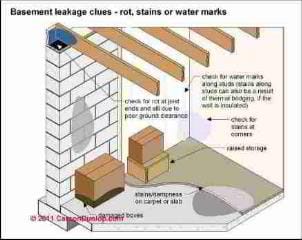
Actual
Carson Dunlop Associates' sketch (left) shows additional clues that easily indicate a history of wet basement: rot at floor joist ends and sill plates atop the foundation wall.
On occasion we find mud in this location, indicating perhaps that the home was previously flooded.
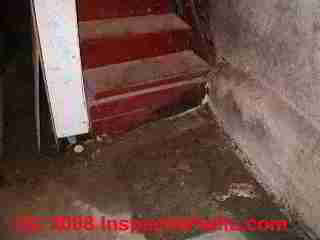
This photo (above) shows strong evidence of a history of water entry through the foundation wall at right: stains on the bottom stair riser appear to emanate right out of the foundation wall.
And that projection of concrete poured along the wall bottom is often a sign of an attempt to retrofit a water seal at a point of water seepage at the wall/floor juncture.
If that guess is correct, that might explain why the stair riser is water stained - the concrete "seal" couldn't extend between the stairs and wall without demolishing and rebuilding the stairs themselves, so behind the first stair tread a leak point remained un-sealed.
A look behind this stair [photo] confirmed just what we thought.
Rusted Metal Beams or Lally Columns Can Indicate Basement Water Entry or High Moisture
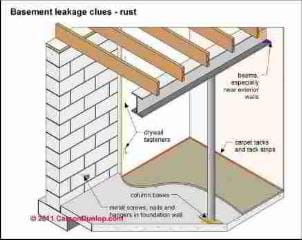
Carson Dunlop Associates' sketch (left) shows places to look for rust as an indicator of basement leaks or high moisture levels:
Rust stains at drywall nails or screws
Rusted or stained carpet tack strips
Heavy rust especially at the base of steel Lally columns or on steel beams (see our photo, below).
Rusted metal screws, nails, and structural connectors connected to the foundation wall
Rusted feet on a basement-located oil tank
Rust or water stains on the bottom of heating equipment that rests on or close to floor level, or if you see that heating equipment has been installed on concrete blocks to lift it above floor level that may also indicate a concern for a history of leaks and water entry.
An example of Carson Dunlop's tip to look for rust or water stains on metal beams is shown in our photograph (below left). This steel girder was supporting a modular home that had been driven in rain and received extensive highway-blown water inside the structure.

Our second structural rust photo (below) was taken in very exciting circumstances.
We were inspecting a house on Long Island when the owner mentioned that she had pumps running 24/7 in the basement to keep the bay at bay.
All of the Lally columns (some were just hollow pipes not real Lallys) were badly rusted. Suddenly the kitchen floor collapsed beneath us.
Details are at COLUMNS & POSTS, DEFECTS.
Also see FLOOD DAMAGE TO FOUNDATIONS.
For problems with settlement of piers below Lally columns
see SETTLEMENT CRACKS in SLABS.
Flood lines on Basement Furnishings or Equipment or Flood Vents indicate Flooding
Our photos below are clear examples of a severe basement flood. If you inspect closely you may find multiple apparent high-water lines on basement surfaces or contents.
Don't assume this is necessarily multiple flooding events. The lines may be multiple separate events, or they may be stages in lowering of the water level in a flooded basement.
Additional clues (such as rotted floor trim) can distinguish between a one-time basement flood and recurrent water entry.
Our second photo (below) shows our inspection client taking a break next to flood lines on a warm air furnace base.
More basement water entry clues: details on walls
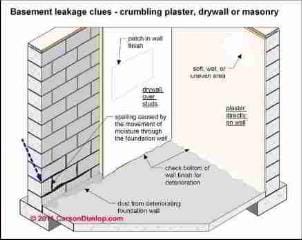
Carson Dunlop Associates' sketch (left) shows additional clues that may point out a history of wet basements:
Concrete block or poured concrete foundation wall spalling
Patches in finished drywall
Deterioration of drywall at or close to floor level
Stains or rotted floor baseboard trim
Where plaster is applied directly to the foundation walls look for soft spots or efflorescence.
Still More Signs of Basement Water Entry & Moisture Sources
Concrete Foundation Wall Leak Points - Leaks at Cold Pour Joints
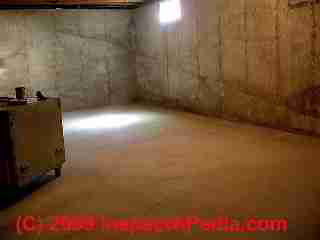
At COLD POUR JOINTS, CONCRETE we discuss the cause and possible significance of cold pour joints on a poured concrete foundation wall.
Usually a cold pour joint in a concrete wall is only of cosmetic import. But if sufficient time elapsed between successive concrete pours into an individual foundation wall, the lower wall concrete "sets up" enough that there is a poor bond between that layer and the next pour of concrete into the wall forms.
The result can be not only a visible "crack" in the poured concrete wall, but this cold pour joint may leak surface water or ground water into the building.
Our photo (above) shows white efflorescence stains left by a long history of building foundation leaks at a cold pour joint on this building.
Also notice that in the corner there was some efflorescence above the cold pour joint, while at the second photo (above) there was efflorescence and leakage only below the cold pour joint. At both of these locations a roof drainage downspout had spilled water against the building wall for many years.
Often, including at this building, the leaks at the concrete wall cold pour joint occurred primarily, or in this case only, where there was a concentration of water spillage outside the building.
In our two photos above, the two areas of leakage, at the cold pour joint in the building corner, and further along to the right of that corner in a lower cold pour joint leak, you can see that water leakage was concentrated (shown by the white efflorescence on the wall).
Our photo at left shows a close up of white mineral salts (efflorescence is discussed
at EFFLORECSENCE & white or brown deposits [Web Article] left on the concrete foundation wall below a leaky cold pour joint.
So routing downspouts well away from the building and terminating the downspout at a location where water will continue to run away from the building rather than back towards it would probably have prevented most or all of this basement water entry problem as well as the mold contamination that it led to.
Concrete Foundation Leak Points - at Form Ties
Form ties are usually steel wires or rods that secure the front and back foundation wall forms in place during a concrete foundation wall pour. After the wall has cured the ties are cut or broken off.
On (usually rare) occasions we find water leaks through the poured foundation wall at the form ties, as shown by the stains in this photo.
The significant volume of leakage along this basement wall suggests that there was an outdoor problem with surface runoff or mishandling of roof runoff around the building.
Concrete Foundation Leak Points - at Wall Cracks
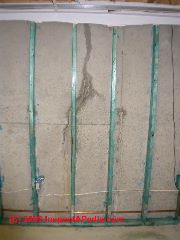
Our photo (left) shows stains at a poured concrete foundation wall crack that had been covered by insulation, drywall, and paneling in a finished basement.
Episodic water leaks through this crack sent water into the wall cavity and below a raised floor in the basement where it was un-noticed until a severe rainfall and leak quantity brought enough water into the basement for water to appear above the finished floor level.
The exact location of the leak was apparent once we removed the basement wall and floor coverings - a step that was necessitated by a mold-contamination problem that originated in basement water leakage.
Concrete Foundation Leak Points - at Floor Slab Shrinkage Gaps & Cold Pour Joints
Our photo (below left) shows a normal concrete floor slab shrinkage gap where the floor (under our pen) abuts a poured concrete foundation wall.
The brown material on the floor is mud which we suspect rose up from below the slab when surface runoff or ground water saturated the soils around and under the floor slab.
Our second photo, above right, shows minor seepage through the concrete foundation wall at cold pour joints.
Most cold pour joints are not leaky, but this one was.
Concrete Block Foundation Leakage at Footing Drains
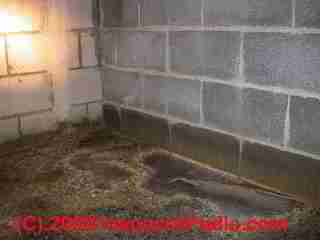
There are two common explanations for the water seepage pattern shown here:
1. The footing drain is absent or clogged - notice that the wall at right looks pretty dry except along that first course of block. This might suggest that water is not running down this foundation wall from above.
2. Sometimes a serious water source along one foundation wall will enter the block walls and travel around to other sides of the foundation through the hollow cores of the masonry blocks.
This circumnavigation of the foundation wall interior through the hollow core concrete blocks is particularly mobile if the basement floor slab is poured half-way up the first course of block, forming a dam that raises water level inside the wall and encouraging water travel in the wall interior.
EIFS Synthetic Stucco Wall or Window Sill Exterior Leaks Show Up in Basement or Garage
Our photo (left) shows water stains down a poured concrete foundation below an EIFS-clad new home.
Leaks at window sills and other exterior EIFS wall penetrations allowed wind-blown rain (or spray from a garden hose) to soak the wall cavity, wall insulation, and to appear as streams down the foundation wall beginning at a height several feet above ground level - compelling evidence that this is not a roof spillage nor ground water leak. It's an exterior wall leak showing up in the basement.
We had a wonderful Gary Larson cartoon here, showing a wet basement, but at Mr. Larson's request removed it. - Ed. You'll just have to think "Gary Larson" an d "Flooded basement" and come up with a funny image.
Basement floor tiles indicate building leak history
Water-damaged, curling, lifting floor tiles are a likely indicator of a basement flood or recurrent wet basement floors. In this basement, all of the floor tiles had come loose, but the rectangular marks show where they had previously been located.
The use of plastic floor baseboard trim (plastic cove molding) in an older home may indicate that water-damaged wood trim or even water-damaged lower portion of drywall close to the floor have been covered with this wider, water-resistant material.
Buckling laminate or wood flooring may indicate high moisture or basement leakage
High moisture, even without actual flooding, can cause wood flooring and some laminate floors to buckle.
This laminate engineered wood floor was badly buckled and eventually just popped up after water had leaked under the floor installation.
...
Continue reading at WET BASEMENT PREVENTION or select a topic from the closely-related articles below, or see the complete ARTICLE INDEX.
Or see these
Recommended Articles
Or see these
Basement / Crawl Area Dry-Out Articles
- BASEMENT DE-WATERING SYSTEMS
- BASEMENT LEAKS, INSPECT FOR
- BASEMENT WATERPROOFING
- CRAWL SPACE DRYOUT
- EFFLORESCENCE SALTS & WHITE DEPOSITS
- FLOOD DAMAGE ASSESSMENT, SAFETY & CLEANUP
- FOUNDATION WATERPROOFING
- FOUNDATION WATERPROOFING: CRACK SEALANTS
- FOUNDATION WATERPROOFING SEALANTS
- GEOTEXTILES & DRAINAGE MATS
- GRADING, DRAINAGE & SITE WORK
- PLUMBING LEAK DETECTION & SHUTOFF DEVICES
- WATER BARRIERS, EXTERIOR BUILDING
- WATER ENTRY FROM BURIED TANKS
- WATER ENTRY in BUILDINGS - home
- WATER ENTRY/DAMAGE PREVENTION WITHOUT GUTTERS
- WET BASEMENT PREVENTION
- WET, DEFINITION OF
- WATER LEAK DETECTION & SHUTOFF DEVICES
Suggested citation for this web page
BASEMENT LEAKS, INSPECT FOR at InspectApedia.com - online encyclopedia of building & environmental inspection, testing, diagnosis, repair, & problem prevention advice.
Or see this
INDEX to RELATED ARTICLES: ARTICLE INDEX to BUILDING LEAKS & WATER ENTRY
Or use the SEARCH BOX found below to Ask a Question or Search InspectApedia
Ask a Question or Search InspectApedia
Questions & answers or comments about how to determine the extent and history of basement water leakage at a building.
Try the search box just below, or if you prefer, post a question or comment in the Comments box below and we will respond promptly.
Search the InspectApedia website
Note: appearance of your Comment below may be delayed: if your comment contains an image, photograph, web link, or text that looks to the software as if it might be a web link, your posting will appear after it has been approved by a moderator. Apologies for the delay.
Only one image can be added per comment but you can post as many comments, and therefore images, as you like.
You will not receive a notification when a response to your question has been posted.
Please bookmark this page to make it easy for you to check back for our response.
Our Comment Box is provided by Countable Web Productions countable.ca
Citations & References
In addition to any citations in the article above, a full list is available on request.
- [1] Alan Carson Carson Dunlop Associates, Toronto, Ontario. Mr. Carson is a home inspection professional, educator, researcher, writer, and a principal of Carson Dunlop Associates, a Toronto home inspection and education firm. Mr. Carson is a past president of ASHI, the American Society of Home Inspectors Some great illustrations of the proper under-roof ventilation pathways are offered by Carson Dunlop.
- [2] Mark Cramer Inspection Services Mark Cramer, Tampa Florida, Mr. Cramer is a past president of ASHI, the American Society of Home Inspectors and is a Florida home inspector and home inspection educator. (727) 595-4211 mark@BestTampaInspector.com 11/06 & 12/08
- [3] John Annunziata, P.E. - NY Metro ASHI during informal chapter discussions about roof and attic ventilation options (1986-1996).
- [4] "Rising Damp", The Building Doctor, Joseph Knight. Mr. Knight is a Chartered Surveyor in the U.K. He can be reached by email at: joeknight@buildingdoctor.com or through his website: http://buildingdoctor.com/
- Our recommended books about building & mechanical systems design, inspection, problem diagnosis, and repair, and about indoor environment and IAQ testing, diagnosis, and cleanup are at the InspectAPedia Bookstore. Also see our Book Reviews - InspectAPedia.
- WEATHER RESISTIVE BARRIERS [PDF] U.S. Department of Energy, ", how to select and install housewrap and other types of weather resistive barriers
- In addition to citations & references found in this article, see the research citations given at the end of the related articles found at our suggested
CONTINUE READING or RECOMMENDED ARTICLES.
- Carson, Dunlop & Associates Ltd., 120 Carlton Street Suite 407, Toronto ON M5A 4K2. Tel: (416) 964-9415 1-800-268-7070 Email: info@carsondunlop.com. Alan Carson is a past president of ASHI, the American Society of Home Inspectors.
Thanks to Alan Carson and Bob Dunlop, for permission for InspectAPedia to use text excerpts from The HOME REFERENCE BOOK - the Encyclopedia of Homes and to use illustrations from The ILLUSTRATED HOME .
Carson Dunlop Associates provides extensive home inspection education and report writing material. In gratitude we provide links to tsome Carson Dunlop Associates products and services.


